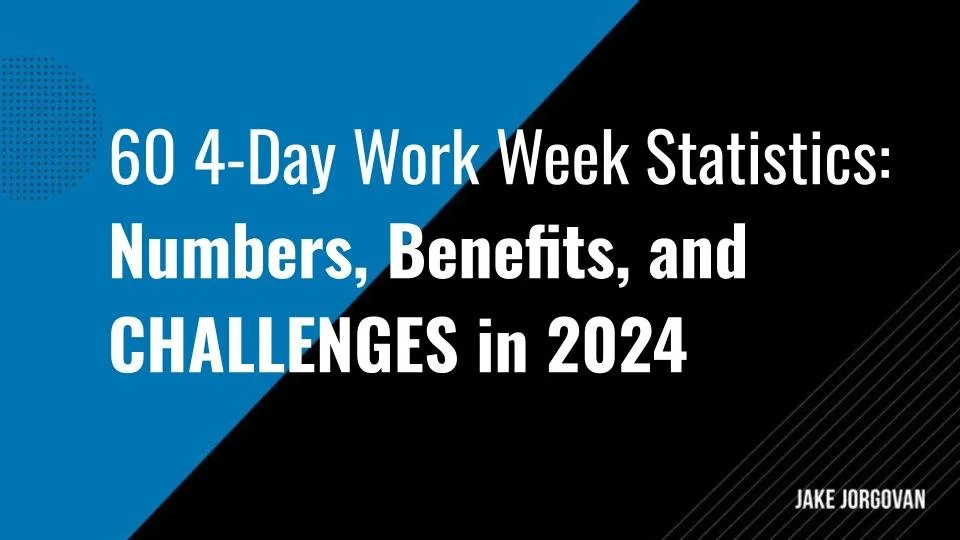60 4-Day Work Week Statistics: Numbers, Benefits, and CHALLENGES in 2024
In recent years, the traditional five-day workweek has been reconsidered, giving rise to the four-day model.
This innovative schedule typically involves 32 hours spread over four days, maintaining full-time pay but promising a three-day weekend.
Traditional models stick to set hours across established weekdays, while compressed versions squeeze the usual 40 hours into fewer days.
This shift is backed by emerging data. Therefore, it suggests not just a feasible alternative but a potentially transformative approach to work-life balance.
Let’s look at those numbers below:
General Statistics
Employee Preferences and Benefits
56% of employees prefer working 40 hours across 4 days rather than 5.
58% of people prefer getting a 4-day workweek instead of a pay raise.
66% of employees see a shorter workweek as an attractive job perk.
77% of employees express greater loyalty to employers who offer a 4-day workweek.
93% of employees in trial programs prefer the 4-day workweek.
59% of employees find more time for personal development with a 4-day week.
60% of employees believe they can complete their work in four days.
60% of workers would choose a 4-day job even with slightly less pay.
3-day weekends led to a 25% increase in focus and concentration during work days.
62% of workers agreed the four-day week improved their social life.
78% of Gen X and baby boomer workers support a four-day workweek.
Women are 5% more likely than men to favor a four-day workweek for potential savings on childcare expenses.
Business and Operational Impact
13. 15% of companies offer a 4-day workweek with less than 32 hours.
14. 33% of organizations currently offer a 4-day, 40-hour workweek.
15. 80% of businesses might adopt flexible schedules by 2025.
16. Operational costs decrease by around 20% with a 4-day week.
17. Businesses report 30% lower absenteeism with a shorter workweek.
18. 85% of employers found productivity stayed the same or improved with a 4-day week.
19. Employee turnover dropped by 57% in organizations that implemented a 4-day workweek.
20. UK businesses adopting a four-day workweek model could collectively save an estimated £104 billion annually.
21. Nearly all U.S. managers, 93% to be precise, prefer a four-day workweek for their team members.
22. Over 64% of UK businesses advocate for the introduction of a four-day workweek.
23. A 4-day workweek can decrease environmental impacts by reducing commute times.
Productivity and Performance
24. 77% of workers notice increased productivity with a 4-day workweek.
25. 85% of businesses observed increased productivity with a 4-day workweek.
26. 42% of employees find fewer distractions in a 4-day workweek setting.
27. Countries testing the 4-day workweek see an average of 8% economic growth.
28. Work-from-home productivity increased by 35% during a 4-day week.
29. 77% of workers believed a four-day workweek would lead to better overall health.
30. Over 55% of surveyed companies experienced financial savings with a 4-day week.
31. In organizations where AI is central to operations, 93% of senior leaders are either considering or have already implemented a 4-day workweek.
32. A significant 63% of employees stated they would look for another job if their current employer did not offer remote or hybrid work options.
33. Research indicates that there are no inherent productivity benefits to the traditional five-day workweek.
34. Retail industries observed a 20% increase in sales volume during the days they were open in a 4-day work week."
Health and Work-Life Balance
35. 78% of employees believe a shorter workweek would improve their work-life balance.
36. 76% of employees think a 4-day week would boost their mental health.
37. 63% of HR managers believe a 4-day workweek enhances work-life balance.
38. 88% of employees feel a three-day weekend enhances their family relationships.
39. 85% of workers reported reduced work-related fatigue with a 4-day week.
40. 40% reduction in the number of sick days taken by employees
41. 71% of businesses saw a reduction in employee burnout.
42. 65% of senior leaders within the 35-44 age range would consider or have adopted a 4-day workweek.
Adoption and Feasibility
43. Germany's metal and electrical industries have options for 4-day workweeks.
44. 64% of business leaders believe the 4-day workweek will be the norm within a decade.
45. 44% of HR professionals doubt the feasibility of a 4-day workweek in their industries.
46. Coordination of schedules is a challenge for 46% of HR professionals.
47. Over 60% of managers notice reduced absenteeism with a 4-day schedule.
48. Only 45% of senior leaders within the 55-64 age range would consider or have already implemented a 4-day workweek.
49. 75% of businesses that have not adopted a four-day workweek cite the need to be available to customers as the primary obstacle.
50. A survey reveals that 28% of Poland workers favor a four-day workweek.
51. In a survey, 54% of Irish and German workers prefer a shorter workweek to a longer salary.
Country-specific Data and Trials
52. Iceland showed no productivity loss with public workers on reduced hours.
53. Spain is running a 32-hour workweek pilot called the "New Normal."
54. In New Zealand, a 4-day workweek trial improved employee satisfaction by 20%.
Challenges and Concerns
55. 62% of businesses feel a 4-day workweek would require salary cuts.
56. 40% of employees are concerned about heavier workloads in a shorter week.
57. Remote work requests drop by 19% in companies with a 4-day workweek.
58. Customer satisfaction improved by 15% in firms adopting a 4-day workweek.
59. Nearly half (46%) of employees are concerned that a 4-day week might harm sales.
60. According to a report, 41% of manufacturing employees, 38% of those in human resources, and 37% of workers in the travel sector believe that a four-day workweek is unrealistic for their fields.
Benefits of a 4-Day Workweek
Impact on Productivity and Business Outcomes
The 4-day workweek has demonstrated substantial positive impacts on productivity, particularly in notable cases like Microsoft Japan. During their 2019 trial, Microsoft Japan reported a 40% increase in productivity.
This experiment involved giving 2,300 employees every Friday off without a pay cut. Employees also experienced improved well-being and reduced stress.
And that translates to fewer sick days and lower absenteeism.
Additionally, the company saw a 23% reduction in electricity costs and a 59% decrease in paper usage, highlighting operational efficiency gains.
These results underscore the significant potential of a 4-day workweek in enhancing productivity and operational efficiency.
Let’s see why you can expect the same benefits:
Improved Employee Well-Being and Reduced Burnout
Implementing a 4-day workweek influences employee well-being and reduces burnout effectively:
Employees report higher satisfaction. The additional day off boosts overall life contentment. Stress levels markedly decrease because a longer weekend allows more time for recovery.
Mental health improvements are common. Reduced work hours lead to less work-related anxiety. Besides, work-life balance is enhanced dramatically because people find more time for personal and family activities.
Physical health benefits are also likely. Less time commuting reduces physical fatigue and strain.
Employee engagement strengthens. Well-rested employees bring more focus and enthusiasm to work.
Burnout rates significantly drop. The extended weekend interrupts the buildup of work stress.
These factors collectively contribute to a healthier, more motivated workforce. The result is sustained productivity and job satisfaction.
Financial Savings and Reduced Overhead Costs
Reducing office days to four each week can cut operational costs significantly:
You see lower electricity bills each month. Fewer office days mean less energy consumed for lighting, heating, and cooling.
Your resource expenses drop notably. Less time in the office reduces the use of office supplies like paper and ink.
Maintenance costs decrease correspondingly. Less frequent use of office facilities slows the wear and tear on office equipment and spaces.
You save on cleaning and upkeep expenses. Fewer days occupied means less frequent need for cleaning services.
Technology costs can also plummet. With more remote work, companies might downscale on hardware investments.
Commuting support costs diminish. Companies that subsidize travel find savings as employees commute less.
Catering expenses see a significant drop. Providing fewer meals and snacks at the office leads to lower catering costs.
These savings collectively enhance your financial flexibility, enabling the reallocation of funds to more strategic initiatives.
4-Day Workweek Challenges and Criticisms
Implementing a 4-day workweek poses unique challenges in certain industries:
Healthcare demands constant patient care. Hospitals require 24/7 availability, complicating reduced hours.
Emergency services cannot compromise on readiness. Police and fire departments need full-time coverage.
Retail relies on consumer accessibility. Shorter weeks reduce operating hours, which would then impact sales.
Hospitality must cater to continuous guest needs. Hotels and restaurants operate beyond standard hours.
Manufacturing schedules depend on production demands. Halting production lines frequently would reduce efficiency.
Transportation and logistics require daily operations. Consistent delivery schedules are essential for business continuity.
These sectors find implementing a shortened workweek challenging due to the necessity of continuous service or production cycles. Adapting to a 4-day model requires innovative scheduling and possibly increased labor costs to maintain service levels.
A 4-day workweek can lead to increased costs due to overtime and staffing in specific industries:
Covering shifts necessitates additional staff. Sectors like healthcare may hire more to maintain coverage.
Overtime costs could spike significantly. Remaining open beyond reduced hours often incurs overtime.
Training part-time staff increases expenses. More hires require additional resources for effective training.
Employee turnover may rise initially. Transitioning to a new schedule might lead to dissatisfaction.
Customer service could require extended staffing. Industries facing customer demand might extend operational hours.
Quality control needs constant supervision. Reduced work days could demand more oversight hours.
These factors indicate that transitioning to a 4-day workweek could necessitate careful financial planning and operational adjustments to manage increased labor costs effectively without compromising service quality or productivity.
Case Studies and Examples
Adopting a four-day work week has proven successful for several companies across various industries, demonstrating enhanced productivity and improved employee well-being.
Elephant Insurance, a U.S.-based auto insurance company, implemented a compressed work schedule in 2020. They reported improvements in employee morale, productivity, and retention rates
Awin, an affiliate marketing platform, embraced a four-day workweek during an 18-month trial across its 1,300-member workforce. This change led to a 13% increase in annual gross profits and a significant drop in employee turnover and sick days.
Wildbit, another U.S. company in the software sector, has been operating on a 4-day workweek since 2017 without increasing daily working hours. The shift led to increased employee focus and motivation, which translated into greater productivity and job satisfaction
Bolt, a technology company, introduced a four-day workweek in 2021. The change was met with strong approval from employees and an increase in productivity. In fact, 87% of managers said that their team was equally productive and efficient in 20% less time.
Future Outlook on the 4-Day Work WeeK
The potential for wider adoption of a 4-day workweek is substantial. Trials and data already suggest positive outcomes for employees and businesses.
You might see more sectors experimenting with reduced hours soon. Technology and remote work trends facilitate this shift, offering necessary flexibility.
Global trials, like those in the UK and New Zealand, may prompt policy changes, influencing others.
Environmental and well-being benefits further enhance the appeal. Continuous innovation in work management tools will support this transition.
However, adoption varies by industry, with some facing logistical challenges.
Watch for a gradual shift as more success stories emerge, influencing broader acceptance.
Here are some insights into future trends and possible legislative changes regarding the 4-day workweek:
Legislative interest will likely increase. Governments may introduce flexible work laws as trials succeed.
Technological advancements will continue to drive change. Automation and AI reduce the need for long hours.
Public sector experiments may set precedents. Success in government settings could lead to wider implementation.
Environmental policies might favor shorter workweeks. Reduced commuting and office use align with green agendas.
Economic pressures could accelerate adoption. As businesses seek efficiency, shorter workweeks become attractive.
Union negotiations may increasingly focus on hours. Labor movements could push for reduced hours without pay cuts.
Backlash and refinement are inevitable. Initial adoption might face resistance, leading to policy tweaks.
These trends suggest a dynamic and evolving discussion around the 4-day workweek, influenced by economic, environmental, and technological factors.
Embracing Efficiency: The Bright Future of the 4-Day Workweek
The 4-day workweek concept has garnered substantial evidence suggesting a positive shift in the modern work paradigm.
Employee preferences strongly lean toward this model, with significant majorities favoring fewer workdays for better work-life balance and overall well-being.
Operational impacts observed include up to 20% cost savings and enhanced productivity levels.
These statistics highlight not just feasibility but also substantial benefits across various sectors.
Moving forward, the potential for broader adoption looks promising, influenced by ongoing successful trials worldwide and increasing legislative interest.
Technological advances and societal shifts towards more sustainable living support this trend, suggesting the 4-day workweek might soon transition from exception to norm in many industries.




